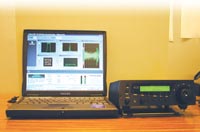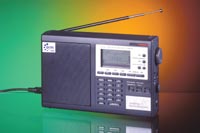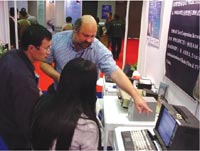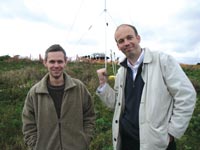Digital radio broadcasts to be launched
at WRC-03

Michel R. Penneroux,
Head of HF Broadcasting,
TéléDiffusion de France (TDF)
ITU 030064 |
Digital AM broadcasting is moving closer to reality after several
years of testing. The Digital Radio Mondiale (DRM) consortium will launch its
inaugural live broadcasts at the World Radiocommunication Conference (WRC-03),
to be held in Geneva from 9 June to 4 July 2003.
DRM is the world’s only non-proprietary, digital system for short-wave,
medium-wave and long-wave radio with the ability to use existing frequencies and
bandwidth across the globe.
Many manufacturers of transmitters and receivers, broadcasters and research
laboratories took an active part in the efforts of Study Group 6 of the ITU
Radiocommunication Sector (ITU–R) and of the DRM consortium to define and
develop a worldwide standard in the LF, MF and HF bands. With clear, near-FM
quality sound that offers a dramatic improvement over analogue, DRM is expected
to revitalize the broadcasting bands below 30 MHz in markets worldwide.

DRM software radio
ITU 030059/VT Merlin Communications
|
In November 2002, ITU Member States approved a revised version of
Recommendation BS1514, now called Recommendation BS1514-1 (Digital Sound
Broadcasting Below 30 MHz). It states that DRM is an ITU–R Recommendation for
all the broadcasting bands spanning from 150 kHz to 30 MHz. This technology
breakthrough promises to open up a new era of quality sound broadcasting for
long, medium and short-wave transmissions.
Digital radio is expected to offer better reception and far superior sound
quality to the consumer. Furthermore, it will deliver a range of new data
services on a radio screen from identifying song titles and artists to scrolling
local traffic, weather and news. Transmitters and first generation receivers
were available from the second half of 2001. But mounting actual services,
beyond test broadcasts, will depend on the regulatory process to be addressed at
WRC-03 under Agenda item 1.2.
|
*This Article states that: “The use of the bands
5 900 — 5 950 kHz, 7 300 — 7 350 kHz,
9 400 — 9 500 kHz, 11 600 — 11 650 kHz,
12 050 — 12 100 kHz, 13 570 — 13 600 kHz,
13 800 — 13 870 kHz, 15 600 — 15 800 kHz,
17 480 — 17 550 kHz, and 18 900 — 9 020 kHz
by the broadcasting service is limited to single-sideband emissions with
the characteristics specified in Appendix II (Table of transmitter
frequency tolerances) or to any other spectrum-efficient modulation
techniques recommended by ITU–R. Access to these bands shall be subject
to the decisions of a competent conference.” |
WRC-03 will review and take action, as required, on Article 5.134* of the
Radio Regulations and several related Resolutions and Recommendations, including
Appendix 11 of these Regulations. It will do so in the light of the recent
studies, which ITU–R Study Group 6 carried out on digital modulation
regarding, in particular, minimum usable field-strengths and protection ratios.
A change in the Rules of Procedure by the ITU Radio Regulations Board, at its
meeting in December 2002, allows for digital modulation on a provisional basis
to any broadcaster who wants to use current assignments in the medium-wave/AM
and long-wave frequency bands for digital broadcasting in Regions 1 (Africa and
Europe) and 3 (Asia and Australasia). While this procedural change does not
cover Region 2 (the Americas), DRM anticipates decisions that will include
Region 2 in the future. Digital broadcasts must conform to the same protection
levels safeguarding other broadcasts (both analogue and digital) already
established for analogue broadcasts in international agreements.
|
 A
production-ready consumer receiver A
production-ready consumer receiver
ITU 030060/Coding Technologies
|
The world’s first DRM broadcasts will be transmitted across the globe on 16
June 2003 during WRC-03. Germany’s Deutsche Welle (DW), Radio Sweden
International and Radio Netherlands have already announced their
participation, with more broadcasters expected to announce their involvement in
the coming weeks. “This joint commencement of daily DRM broadcasts by media
organizations worldwide will forever alter the industry landscape,” comments
DRM Chairman, Peter Senger.
|

Tests and equipment
ITU 030060/BBC
|
“We congratulate DRM on the official start of its broadcasts and will do
everything possible to help DRM become a success for millions of our listeners
around the world. In turn, we expect the receiver-manufacturing industry to be
just as committed by developing suitable receivers,” says DW’s
Director-General, Erik Bettermann. Deutsche Welle will broadcast 12 programme
hours per day in German and English to target regions in Europe.
| Anticipated
benefits of digital AM in a nutshell
For broadcasters:
- Continued use of existing transmission systems.
- Continued (and more efficient) use of existing frequency planning.
- Independent editorial control.
- Control of coverage area.
- Rapid and short-term flexibility when required.
- Opportunities for value-added services with data, text and other
services.
- Better audio quality for listeners, wherever they live.
- Increased audience interest, resulting from audio quality
improvement and additional services.
- Increased advertising interest, resulting from increased audience
interest.
For listeners:
- FM-like sound quality with AM reach.
- Improved reception quality.
- Flexible use of radio whenever and wherever listeners want it.
- No change to existing listening habits, for example, same
frequencies, same listening conditions (fixed, portable and mobile
radio), and same listening environment (indoors, in cities, in dense
forests...).
- Low-cost receiver, low-energy consumption.
- Easy tuning, with selection by frequency, station name or programme
type.
- More diverse programme content, using the full capabilities of new
digital features.
- Wide receiver range with more and better features.
- Radios that will give you programmes with associated text
information, station name, record title, singer’s name...
For manufacturers of digital AM receivers,
transmitters and semiconductors:
- Opportunity to identify possibilities for new areas of interest.
- Increase the market potential for transmitting and receiver systems.
- Optimize return on investment for dual technology components for low
data rate systems applied to narrow-band transmission channels.
- Opportunity to influence the cost-effective design cost of future AM
radio systems.
- Opportunity to replace 2.5 billion receivers with digital AM
receivers.
|
| |

A demonstration of DRM live transmissions in China
ITU 030062/VT Merlin Communications |
| |

BBC engineers in front of a low-power transmitter antenna in rural England,
preparing to conduct single-frequency-network tests on 26 MHz
ITU 030065/BBC
|
Radio Netherlands will commence its live, daily Digital Radio Mondialeï
(DRMï) broadcasts in conjunction with DRM’s inaugural broadcasts event in
Geneva. “As a founding member of DRM, Radio Netherlands has been involved in
the on-air system’s development from conception to the current test
transmissions phase,” says Jan Hoek, Radio Netherlands’ Deputy Director
General and CFO/CTO, and DRM Vice Chairman. “In June, we will proudly step
into the next phase of DRM — daily, live broadcasts. Radio Netherlands will
broadcast 37 programme hours per week in English and Dutch to Australia, New
Zealand and target regions in Europe. From 5 July to 27 July 2003, Radio
Netherlands will broadcast Radio Tour de France.
With the FM bands nearly congested and the poor quality of AM, digital AM
radio is expected to offer many advantages to broadcasters seeking to recapture
market shares. For manufacturers, digital AM brings a second lease of life to
older AM technologies with increased market potential for transmitters and
receivers. The benefit for equipment and semi-conductor manufacturers is clear:
there are some 2.5 billion radio receivers that will ultimately be candidates
for replacement, of which nearly 700 million are for short-wave reception, along
with an estimated 1000 transmitters worldwide.
Until digital AM radio audiences reach a significant level, both analogue and
digital broadcasts will be provided. Receiver manufacturers are expected to
provide the market with multi-standard receivers to enable the reception of
analogue AM and FM, as well as digital AM stations.
In vacant AM channels, broadcasters will be able to launch full digital AM as
the receivers will recognize both analogue and digital signals. It is
anticipated that as digital services become more commonplace and the receiver
base builds up, analogue services will be gradually phased out altogether.
Success will depend on whether DRM receivers are out there at the right price
and in sufficient quantities.
| Mr Penneroux joined the
broadcasting industry in 1979 as Aid to the President of Sofirad (Société
Financière de Radiodiffusion — a publicly controlled holding
company investing in media). He has been with TDF since 1989, and became
Head of HF Broadcasting in July 1999. He represents TDF on the DRM
Steering Board. |
|